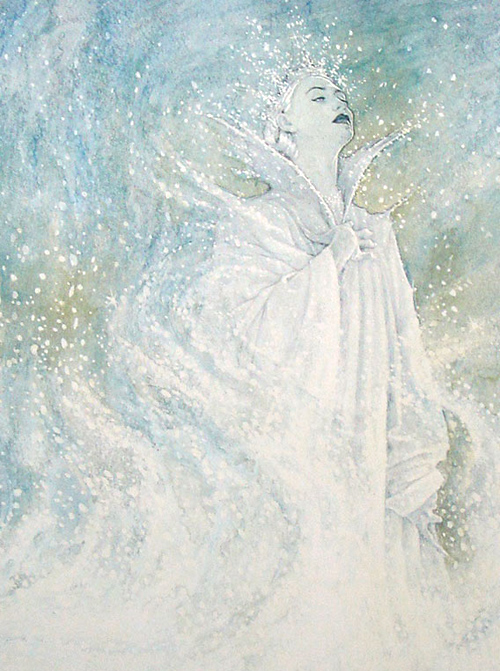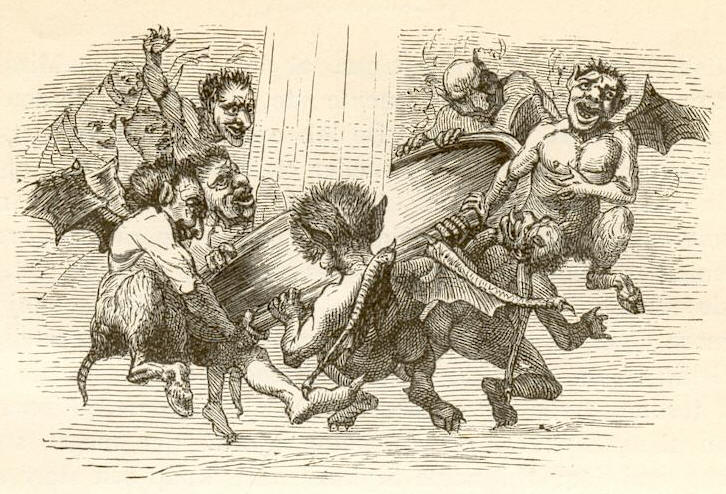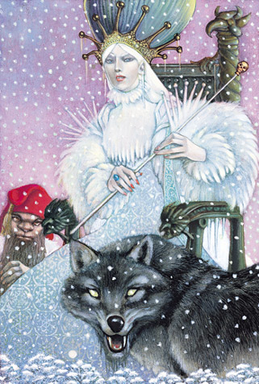 |
| 'The Snow Queen', PJ Lynch 1994 |
Long before the advent of 'Frozen', winter witches subtly graced the pages of literature. Though limited appearances till now, they are some of the most intriguing and powerful sorceresses in the whole catalogue of folklore.
 |
| 'The Snow Queen',Vladislav Erko 2000 |
In December of 1844 one of the first winter witches was fictionalized by an author named Hans Christian Andersen, in a story titled:
The Snow Queen. Andersen is most famous for his tragic tale of the sea titled:
The Little Mermaid. The Snow Queen, second in popularity to Andersen's work is actually one of a few of his tales that does not end on a tragic note. The story is weaved with subtle Christian folkloric elements, utilizing the means of Angels and Demons.
 |
| 'The Snow Queen', Tomislav Tomić 2010 |
The tale begins when an evil Troll called the 'Devil' creates a magic mirror that manipulates the appearance of it's reflections. He toils with personal pupils who follow him around the earth carrying the heavy mirror.
 |
| Vilhelm Pedersen, 1845 |
"In this mirror the most beautiful landscapes looked like boiled spinach, and the best persons were turned into frights, or appeared to stand on their heads; their faces were so distorted that they were not to be recognised; and if anyone had a mole, you might be sure that it would be magnified and spread over both nose and mouth." (Andersen, 1844)
 |
| 'The Snow Queen',Vladislav Erko 2000 |
"That's glorious fun!" said the sprite. If a good thought passed through a man's mind, then a grin was seen in the mirror, and the sprite laughed heartily at his clever discovery. All the little sprites who went to his school--for he kept a sprite school--told each other that a miracle had happened; and that now only, as they thought, it would be possible to see how the world really looked. They ran about with the mirror; and at last there was not a land or a person who was not represented distorted in the mirror. So then they thought they would fly up to the sky, and have a joke there. The higher they flew with the mirror, the more terribly it grinned: they could hardly hold it fast. Higher and higher still they flew, nearer and nearer to the stars, when suddenly the mirror shook so terribly with grinning, that it flew out of their hands and fell to the earth, where it was dashed in a hundred million and more pieces. And now it worked much more evil than before; for some of these pieces were hardly so large as a grain of sand, and they flew about in the wide world, and when they got into people's eyes, there they stayed; and then people saw everything perverted, or only had an eye for that which was evil. This happened because the very smallest bit had the same power which the whole mirror had possessed. Some persons even got a splinter in their heart, and then it made one shudder, for their heart became like a lump of ice. Some of the broken pieces were so large that they were used for windowpanes, through which one could not see one's friends. Other pieces were put in spectacles; and that was a sad affair when people put on their glasses to see well and rightly. Then the wicked sprite laughed till he almost choked, for all this tickled his fancy. The fine splinters still flew about in the air: and now we shall hear what happened next." (Andersen, 1844)
 |
| 'The Snow Queen',Vladislav Erko 2000 |
The story centers around two childhood friends Gerda and Kai who live amidst lush flowers and vegetables that grow in window boxes on the garrets of their adjacent roofs. After likening falling snow to a swarm of bees, Kai asks his grandmother if "Snow Bees" have a queen. She responds,"she flies where the swarm hangs in the thickest clusters. She is the largest of all; and she can never remain quietly on the earth, but goes up again into the black clouds. Many a winter's night she flies through the streets of the town, and peeps in at the windows; and they then freeze in so wondrous a manner that they look like flowers." Later looking out the window Kai sees the Snow Queen who beckons him to follow. He draws back in fear, "at last it was like a young lady, dressed in the finest white gauze, made of a million little flakes like stars. She was so beautiful and delicate, but she was of ice, of dazzling, sparkling ice; yet she lived; her eyes gazed fixedly, like two stars; but there was neither quiet nor repose in them."
 |
| 'The Snow Queen', Debra McFarlane 2007 |
Later in the summertime Kai is affected by the 'Devil's' broken mirror when several shards fall from the sky and pierce his eyes and heart. He is corrupted and becomes cruel. He pokes fun at his Grandmother and no longer cares for his friend Gerda. The next winter Kai hitches his sled to a white snow carriage that is being operated by the Snow Queen, she offers him two magic kisses, one to numb his body to the cold and another to make him forget his past, a third kiss would surely kill him. (This magical kiss of protection predates the most famous one given to Dorothy before she sets down the Yellow Brick Road in the Wonderful Wizard of Oz. The Sorceress who kisses the child is called the Good Witch of the North, the North perhaps is allegorical to the Winter.)
 |
| The Snow Queen by Anastasia Arkhipova |
The journey in this tale really begins when Gerda sets out to find her companion, traveling through many lands and working through many obstacles to save him. While in the Snow Queens dominion, the Land of Permafrost, Kai is given a task. If he can form the pieces of a puzzle that spell 'Eternity' together then the sorceress will set him free. Kai is ultimately saved by Gerda's love when she cries warm tears upon him, melting his heart and melting the piece of mirror lodged inside. In turn Kai's tears remove the fragments from his eyes and his vision is no longer distorted. They delight in joyful dance and ironically kick the pieces of the puzzle into their rightful place, securing Kai's freedom from the sorceress.
 |
| 'The Snow Queen',Vladislav Erko, 2000 |
Though very powerful and superior to the central characters, the Snow Queen does not dominate or try to destroy the heroines success. Rather, she provides a pseudo-safe haven for Kai as Gerda adventures to him. It can be argued that the true hero in this tale is she, for without her protection Kai might have been lost to the world. The Snow Queen is in league with knowing both of the angels and demons sensibilities, and she exists behind the scenes overseeing forces that are more intune to her senses, i.e. winter and snow.
 |
| Vera Smirnova, Palekh, 2011 |
Over a hundred years after the publication of The Snow Queen, another sorceress emerged into literature, Jadis the White Witch. Jadis is the antagonist of C.S. Lewis' Chronicles of Narnia. She first appears to one of the central characters named Edmond Pevensie in a similar fashion to The Snow Queen and Kai. She approaches the child by means of sleigh and wears an elaborate fur coat. Her greatest feat was freezing the whole of Narnia for a hundred years. C.S. Lewis in later books eventually characterizes her as a Northern Witch (,perhaps another origin for the famous witch in Oz).
The Narnian Snow Queen is a little more ruthless than Andersen's. She takes pleasure toiling with the world and desires full control, where Andersen's was simply interested in the powers of winter. And while Edmond is taken to her frozen palace, it is definitely not for protection. Although Human in appearance, Jadis is eventually described as half-Jinn and half-giantess. C.S. Lewis, like Hans Christian Andersen also pays homage to Christian folklore. In his tale the central characters from our world are described as 'Sons of Adam and Daughters of Eve'. Folkloric theologians have claimed that Jadis is the descendant of Adam's first wife Lilith, and thus from pure evil and not human at all.
 |
| Tilda Swinton as Jadis the White Witch, Disney's Lion Witch and the Wardrobe 2005 |
C.S. Lewis definitely drew inspiration for his queen from Hans Christian Andersen's earlier work, for she has the ultimate power and casts the world into perpetual winter. In a later work titled: The Magicians Nephew, we learn of Jadis' powerful sister who was also considered a Northern Witch. (Again there are influences most assuredly between Hans Christian Andersen's Snow Queen, C.S. Lewis' Chronicles of Narnia and L. Frank Baum's Wonderful Wizard of Oz.)
 |
| 'The Snow Queen', Nika Goltz |
Andersen's Snow Queen also had a sister tied to nature, but in antithesis is likened to the ancient earth goddess Mother Nature. She is called, 'The Old Lady Who Knew Magic'. In the story she keeps a small home near a river where she has enchanted the area around her cottage to constantly remain in summer. Gerda on her quest to save Kai stumbles upon the witches garden and is so enchanted she nearly remains trapped in the witches simple realm, where the enchantments have cleared her mind of her quest. Gerda breaks the simple spell when she thinks upon roses, which were among Kai's favorite.
 |
| "The Snow Queen', Boris Diodorov |
'The Old Lady Who Knew Magic' is relatable to classic ideas about an anthropomorphized Mother Nature, as she is giving and nurturing. The fascinating element here is that by trying to keep Gerda from her path she is also overbearing, like so many mothers.
 |
| Goddess of Earth by Phung Vu Lien Phuong |
Traces of Mother Nature can be found throughout the world dating back as far as the middle ages and ancient Greece. The word nature in Latin (Natura) translates to meaning birth, or character. In an old English world earth was personified (Eorthe) as a goddess. The Grecian Goddess "Mother Gaia", the Mesopotamian "Ishtar", and the Norse Goddess "Jord" (Earth) are all representatives of the personification of Earth. Many Native tribes all over the world, American and aboriginal refer to the Earth as Mother.
 |
| By Roslyne Sophia Breillat |
Myths about Mother Nature around the world share a common element, water. Water is a representation of the constant flow of life. People have searched the world for sacred water, to cure ailments, to even regenerate life. "Water is the source of our existence, nurtured as we were in our mothers' amniotic fluid. The faeries gift of pure water is thus a potent one, cleansing and purifying the soul. It is the gift of life. In times past, the water of faeries springs was sought as a cure for infertility. Fertility Faeries, or Green Ladies, could become overenthusiastic in their work, however, enticing men into the woods, leading them on a merry dance, and leaving them exhausted...or worse."--- (Brian Froud, Good Faeries & Bad Faeries, 1998)
 |
| 'The Snow Queen',Vladislav Erko 2000 |
Snow Queens are likened to Green Ladies because they take the power of water and translate it into a 'frozen' realm.
Source Material:
- Dictionary.com
- Online-literature.com
- Pinterest.com
- Wikipedia.com
- The Lion, the Witch and the Wardrobe by C.S. Lewis , Macmillan Publishing Co, 1950
- Good Faeries & Bad Faeries by Brian Froud, Simon & Schuster, 1998
- The Snow Queen by Hans Christian Andersen, 1844
Artists:
- PJ Lynch
- Vladislav Erko
- Tomislav Tomić
- Vilhelm Pedersen
- Debra McFarlane
- Anastasia Arkhipova
- Leo & Diane Dillon
- Nika Goltz
- Boris Diodorov
- Phung Vu Lien Phuong
- Roslyne Sophia Breillat

















No comments:
Post a Comment